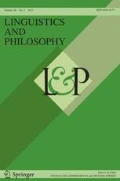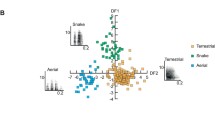Abstract
We develop a formal semantic analysis of the alarm calls used by Campbell’s monkeys in the Tai forest (Ivory Coast) and on Tiwai island (Sierra Leone)—two sites that differ in the main predators that the monkeys are exposed to (eagles on Tiwai vs. eagles and leopards in Tai). Building on data discussed in Ouattara et al. (PLoS ONE 4(11):e7808, 2009a; PNAS 106(51): 22026–22031, 2009b and Arnold et al. (Population differences in wild Campbell’s monkeys alarm call use, 2013), we argue that on both sites alarm calls include the roots krak and hok, which can optionally be affixed with -oo, a kind of attenuating suffix; in addition, sentences can start with boom boom, which indicates that the context is not one of predation. In line with Arnold et al., we show that the meaning of the roots is not quite the same in Tai and on Tiwai: krak often functions as a leopard alarm call in Tai, but as a general alarm call on Tiwai. We develop models based on a compositional semantics in which concatenation is interpreted as conjunction, roots have lexical meanings, -oo is an attenuating suffix, and an all-purpose alarm parameter is raised with each individual call. The first model accounts for the difference between Tai and Tiwai by way of different lexical entries for krak. The second model gives the same underspecified entry to krak in both locations (= general alarm call), but it makes use of a competition mechanism akin to scalar implicatures. In Tai, strengthening yields a meaning equivalent to non-aerial dangerous predator and turns out to single out leopards. On Tiwai, strengthening yields a nearly contradictory meaning due to the absence of ground predators, and only the unstrengthened meaning is used.
Similar content being viewed by others
References
Arnold, K., Keenan, S., Lemasson, A., & Zuberbühler, K. (2013). Population differences in wild Campbell’s monkeys alarm call use. Manuscript, University of St Andrews.
Arnold, K., Pohlner, Y., & Zuberbühler, K. (2008). A forest monkey's alarm call series to predator models. Behavioral Ecology and Sociobiology, 62, 549–559.
Arnold, K., Pohlner, Y., & Zuberbühler, K. (2011). Not words but meanings? Alarm calling behaviour in a forest guenon. Developments in Primatology: Progress and Prospects, 35, 437–468.
Arnold, K., & Zuberbühler, K. (2006a). The alarm calling system of adult male putty-nosed monkey Cercopithecus nictitans martini. Animal Behaviour, 72, 643–653.
Arnold, K., & Zuberbühler, K. (2006b). Semantic combinations in primate calls. Nature, 441, 303.
Arnold, K., & Zuberbühler, K. (2008). Meaningful call combinations in a non-human primate. Current Biology, 18(5), R202–R203.
Arnold, K., & Zuberbühler, K. (2012). Call combinations in monkeys: Compositional or idiomatic expressions? Brain and Language, 120(3), 303–309.
Arnold, K., & Zuberbühler, K. (2013). Female putty-nosed monkeys use experimentally altered contextual information to disambiguate the cause of male alarm calls. PLoS ONE, 8(6), e65660. doi:10.1371/journal.pone.0065660.
Berwick, R. C., Okanoya, K., Beckers, G. J. L., & Bolhuis, J. J. (2011). Songs to syntax: The linguistics of birdsong. Trends in Cognitive Sciences Elsevier, 15(3), 113–121.
Binmore, K., & Samuelson, L. (1999). Evolutionary drift and equilibrium selection. Review of Economic Studies, 66(2), 363–393.
Blumstein, D. T. (1999). The evolution of functionally referential alarm communication: Multiple adaptations, multiple constraints. Evolution of Communication, 3, 135–147.
Caro, T. M. (2005). Antipredator defenses in birds and mammals. Chicago: University of Chicago Press.
Cäsar, C., Byrne, R., Young, R. J., & Zuberbühler, K. (2012). The alarm call system of wild black-fronted titi monkeys Callicebus nigrifrons. Behavioral Ecology and Sociobiology, 66(5), 653–667.
Cheney, D., & Seyfarth, R. (1990). How monkeys see the world: Inside the mind of another species. Chicago: University of Chicago Press.
Chierchia, G., Fox, D., & Spector, B. (2012). The grammatical view of scalar implicatures and the relationship between semantics and pragmatics. In P. Portner, C. Maienborn, & K. von Heusinger (Eds.), Semantics: An international handbook of natural language meaning. (Vol. 3, pp. 2297–2332). Berlin: Mouton de Gruyter.
Chomsky, N. (1957). Syntactic structures. The Hague: Mouton.
Fichtel, C., & Kappeler, P. M. (2002). Anti-predator behavior of group-living Malagasy primates: Mixed evidence for a referential alarm call system. Behavioral Ecology and Sociobiology, 51(3), 262–275.
Fleiss, J. L. (1981). Statistical methods for rates and proportions. New York: Wiley.
Glenn, M. E. (1996). The natural history and ecology of the Mona Monkey (Cercopithecus mona Schreber 1774) on the Island of Grenada, West Indies. Ph.D. Dissertation, Northwestern University, Evanston‘ IL.
Grice, P. (1975). Logic and conversation. In P. Cole & J. Morgan (Ed.), Syntax and semantics, 3: Speech acts. New York: Academic Press.
Guschanski, K., Krause, J., Sawyer, S., Valente, L. M., Bailey, S., Finstermeier, K., Sabin, R., Gilissen, E., Sonet, G., Nagy, Z. T., Lenglet, G., Mayer, F., & Savolainen, V. (2013). Next-generation museomics disentangles one of the largest primate radiations. Systematic Biology, 62(4), 539–554.
Halle, M., & Marantz, A. (1994). Some key features of distributed morphology. In A. Carnie & H. Harley (Eds.), Papers on phonology and morphology (Vol. 21, pp. 275–288). Cambridge: MITWPL.
Horn, L. R. (1972). On the semantic properties of logical operators in English. PhD Thesis, University of California, LA.
Horsburgh, K. A., Matisoo-Smith, E., Glenn, M. E., & Bensen, K. J. (2002). A genetic study of a translocated Guenon: Cercopithecus mona on Grenada. In M. E. Glenn & M. Cords (Eds.), The Guenons: Diversity and adaptation in African Monkeys. Developments in Primatology: Progress and Prospects (pp. 99–109). Dordrecht: Kluwer.
Keenan, S., Lemasson, A., & Zuberbu¨hler, K. (2013). Graded or discrete? A quantitative analysis of Campbell’s monkey alarm calls. Animal Behavior, 85, 109–118.
Kuhn. J. (2013). Do Campbell’s monkeys have linguistic morphology? Seminar Paper, NYU. Available online March 10, 2014, from https://files.nyu.edu/jdk360/public/papers/Kuhn-oo-suffix-draft.pdf.
Lachlan, R. F. (2006). Bird song dialects. In K. Brown (Ed.), The encyclopedia of language and linguistics (2nd ed., p. 538). Oxford: Elsevier.
Landis, J. R., & Koch, G. G. (1977). The measurement of observer agreement for categorical data. Biometrics, 33(1), 159–174.
Lemasson, A., Gautier, J.-P., & Hausberger, M. (2003). Vocal similarities and social bonds in Campbell’s monkey (Cercopithecus campbelli). Comptes Rendus—Biologies, 326, 1185–1193.
Lemasson, A., Glas, L., Barbu, S., Lacroix, A., Guilloux, M., Remeuf, K., & Koda, H. (2011a) Youngsters do not pay attention to conversational rules: Also in nonhuman primates? Scientific Reports, 1, 22.
Lemasson, A., & Hausberger, M. (2011). Acoustic variability and social significance of calls in female Campbell’s monkeys (Cercopithecus campbelli campbelli). Journal of the Acoustical Society of America, 129(5), 3341–3352.
Lemasson, A., Ouattara, K., Bouchet, H., & Zuberbühler, K. (2010). Speed of call delivery is related to context and caller identity in Campbell’s monkey males. Naturwissenschaften, 97(11), 1023–1027.
Lemasson, A., Ouattara, K., Petit, E. J., & Zuberbühler, K. (2011b). Social learning of vocal structure in a nonhuman primate? BMC Evolutionary Biology, 11, 362.
Lemasson, A., Zuberbühler, K., & Hausberger, M. (2005). Socially meaningful vocal plasticity in Campbell’s monkeys. Journal of Comparative Psychology, 119(2), 220–229.
Magri, G. (2009). A theory of individual-level predicates based on blind mandatory scalar implicatures. Natural Language Semantics, 17(3), 245–297.
Manser, M. B. (2001/2002). The acoustic structure of suricates’ alarm call varies depending on predator type and the level of response urgency. Proceedings of the Royal Society of London. Series B: Biological Sciences, 268, 2315–2324.
Marshall, A. J., Wrangham, R. W., & Arcadi, A. C. (1999). Does learning affect the structure of vocalizations in chimpanzees? Animal Behaviour, 58(4), 825–830.
Ouattara, K., Lemasson, A. & Zuberbühler, K. (2009a). Campbell’s monkeys use affixation to alter call meaning. PLoS ONE, 4(11), e7808.
Ouattara, K., Lemasson, A., & Zuberbühler, K. (2009b). Campbell’s monkeys concatenate vocalizations into context-specific call sequences. PNAS, 106(51), 22026–22031.
Ouattara, K., Zuberbühler, K., N’Goran, E. K., Gombert, J.-E., & Lemasson, A. (2009c). The alarm call system of female Campbell’s monkeys. Animal Behaviour, 78, 35–44.
Owings, D. H., & Virginia, R. A. (1978). Alarm calls of California ground squirrels (Spermophilus beecheyi). Zeitschrift für Tierpsychologie, 46(1), 58–70.
Perelman, P., Johnson, W. E., Roos, C., Seuánez, H. N., Horvath, J. E., Moreira, M. A. M., Kessing, B., Ponitus, J., Roelke, M., Rumpler, Y., Schneider, M. P. C., Silva, A., O Brien, S. J.,&Pecon-Slattery, J. (2011). A molecular phylogeny of living primates. PLoS Genetics, 7(3), e1001342.
Schel, A. M., Tranquilli, S., & Zuberbühler, K. (2009). The alarm call system of two species of black-and-white colobus monkeys (Colobus polykomos and Colobus guereza). Journal of Comparative Psychology, 123(2), 136–150.
Schlenker, P. (to appear). The semantics/pragmatics interface. In M. Aloni & P. Dekker (Eds.), Cambridge Handbook of Semantics. Cambridge: Cambridge University Press.
Seyfarth, R. M., & Cheney, D. L. (1986). Vocal development in vervet monkeys. Animal Behaviour, 34(6), 1640–1658.
Seyfarth, R. M., Cheney, D. L., & Marler, P. (1980a). Monkey responses to three different alarm calls: Evidence of predator classification and semantic communication. Science, 210, 801–803.
Seyfarth, R. M., Cheney, D. L., & Marler, P. (1980b). Vervet monkey alarm calls: Semantic communication in a free-ranging primate. Animal Behaviour, 28, 1070–1094.
Sieving, K. E., Hetrick, S. A., & Avery, M. L. (2010). The versatility of graded acoustic measures in classification of predation threats by the tufted titmouse Baeolophus bicolor: Exploring a mixed framework for threat communication. Oikos, 119, 264–276. doi:10.1111/j.1600-0706.2009.17682.x.
Skyrms, B. (1996). Evolution and the social contract. Cambridge: Cambridge University Press.
Spector, B. (2007). Aspects of the pragmatics of plural morphology: On higher-order implicatures. In U. Sauerland & P. Stateva (Eds.), Presupposition and implicature in compositional semantics (pp. 243–281). Houndsmills: Palgrave Macmillan.
Stalnaker, R. C. (2002). Common ground. Linguistics and Philosophy, 25(5–6), 701–721.
Stephan, C., & Zuberbühler, K. (2008). Predation increases acoustic complexity in primate alarm calls. Biology Letters, 4(6), 641–644.
Struhsaker, T. T. (1967). Auditory communication among vervet monkeys (Cercopithecus aethiops) . In S. A. Altmann (Ed.). Social Communication Among Primates (pp. 281.324). Chicago: University of Chicago Press.
Templeton, C. N., Greene, E., & Davis, K. (2005). Allometry of alarm calls: Black-capped chikadees encode information about predator size. Science, 308, 1934–1937.
Wheeler, B. C., & Fischer, J. (2012). Functionally referential signals: A promising paradigm whose time has passed. Evolutionary Anthropology, 21, 195–205.
Zuberbühler, K., Noë, R. R., & Seyfarth, R. M. (1997). Diana monkey long-distance calls: Messages for conspecifics and predators. Animal Behavior, 53(3), 589–604.
Zuberbühler, K. (2000). Interspecies semantic communication in two forest primates. Proceedings of the Royal Society of London. Series B: Biological Sciences, 267, 713–718.
Zuberbühler, K. (2002). A syntactic rule in forest monkey communication. Animal Behaviour, 63(2), 293–299.
Author information
Authors and Affiliations
Corresponding author
Additional information
For helpful comments, we wish to thank David Adger, Jean-Baptiste André, Ariel Cohen, Ashwini Deo, James Fuller, Jean-Pierre Gautier, Daniel Harbour, Stephanie Harves, Jeremy Kuhn, Ad Neeleman, Franck Ramus, Dunja Veselinovic, Ede Zimmermann, as well as audiences at the following institutions: Semantics and Linguistic Theory (SALT 23) at UC Santa Cruz (2013); annual meeting of the Linguistic Association of Great Britain 2013 (Workshop on ‘Primate Grammar (and Beyond)’); University of Amsterdam; Département d’Etudes Cognitives, ENS, Paris; NYU Abu Dhabi. Some figures and the bibliography were prepared with Lucie Ravaux’s help.
Rights and permissions
About this article
Cite this article
Schlenker, P., Chemla, E., Arnold, K. et al. Monkey semantics: two ‘dialects’ of Campbell’s monkey alarm calls. Linguist and Philos 37, 439–501 (2014). https://doi.org/10.1007/s10988-014-9155-7
Published:
Issue Date:
DOI: https://doi.org/10.1007/s10988-014-9155-7




